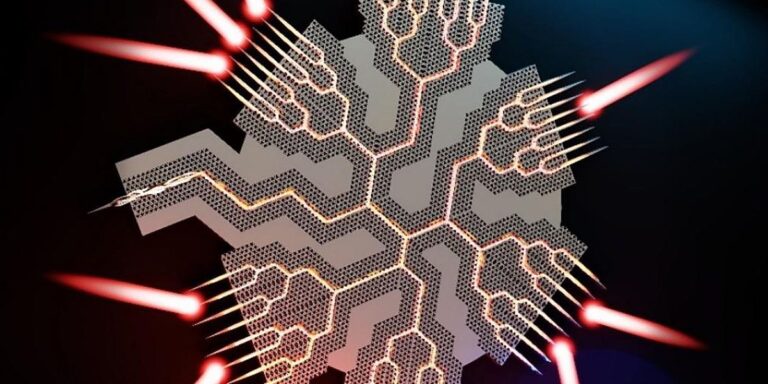Terahertz waves could help future wireless networks achieve terabit-per-second data rates, but their applications are typically limited by the short distances over which they are effective. Now, scientists have developed a way to efficiently shape terahertz beams using on-chip devices, which can send signals directly to specific devices, making connections stronger and more reliable. The researchers’ prototype chip can support four real-time uncompressed HD video streams simultaneously, or eight 40-gigabit-per-second wireless links.
Terahertz waves lie between light waves and microwaves on the electromagnetic spectrum. As the name suggests, their frequencies range from 0.1 terahertz to 10 terahertz. These relatively unused waves are the key to higher bandwidths. Future 6G Wireless Networks And more.
Terabit links could ultimately support a wide range of applications, including faster internet connections, autonomous vehicles, virtual and augmented reality without delays or interruptions, remote surgery, smart cities and ultra-high-definition video streaming of 8K or 18K, says Ranjan Singh, a professor of electrical engineering at the University of Notre Dame in Indiana and Nanyang Technological University in Singapore.
Problems with terahertz waves
Finding an efficient way to shape terahertz beams is essential to making terahertz wireless communication a reality. “A beamformer is a smart antenna that focuses wireless signals in a specific direction rather than sending them all over the place,” says Singh. “Beamformers make communications more efficient by focusing the signal exactly where it’s needed, instead of spreading it all over the place. This focused signal can reach farther and maintain better quality over long distances.” Additionally, “By sending the signal in a specific direction, the beamformer reduces interference with other devices and makes the connection more stable.”
However, current terahertz beamformers face many challenges, including power consumption, limited bandwidth, large device size, and limitations on the direction in which the beam can be pointed.
Shin and his colleagues have developed an on-chip, multi-link, broadband terahertz beamformer that can emit radio beams in all directions around the device, leveraging the emerging field of topological photonics.
topology The branch of mathematics that studies what features of a shape can withstand deformation. For example, an object shaped like a doughnut can be pushed and pulled into the shape of a mug, and the hole in the doughnut becomes the hole in the cup’s handle, but it cannot be deformed into a shape without tearing.
Using insights from topology, researchers created the first electronic topological insulator in 2007. Electrons moving along the edges or surfaces of these materials continue to flow despite the many obstacles they may encounter — topologically speaking, a bit like a doughnut, which maintains the same shape unless some change is made to add or remove a hole.
Recently, scientists Photonic topological insulator Photons are similarly “topologically protected”: these materials have a structure that allows light of certain wavelengths to flow through them without scattering or being lost, even around corners and imperfections.
Focus on Terahertz Topology
In the new study, with the help of neural network-aided design, the researchers fabricated a silicon chip and drilled rows of triangular holes, where the width of each triangle alternated between about 84.9 micrometers and 157.6 micrometers. The holes were arranged in clusters, with the row of smaller triangular holes facing in the opposite direction from the row of larger holes. In some clusters, the large triangular holes all faced up, while in other clusters they all faced down.
The light entering the chip is topologically protected and travels along the edges between different clusters of triangular holes. Topological protection allows the light inside the chip to be guided around tight turns and tight spaces, allowing the researchers to shrink the entire beamformer to the size of the chip. The scientists explained in detail: Their findings July 14th Journal Nature.
This new topological beamformer can enable 72 Gbps chip-to-chip wireless links over 30 centimeters with low power loss. The device can be excited with light and adjust the number of channels it hosts on demand by turning off any of the 48 beams it can emit.
“At current Wi-Fi speeds, it takes 11 minutes to download a 4K UHD video, but with our 72 Gbps terahertz beamformer chip, it will be possible to download it in six seconds,” Singh said.
Currently, Singh is focused on integrating terahertz electronics and photonics onto a single chip platform. One major challenge facing this research is the current lack of efficient power amplifiers and electronic oscillators at terahertz frequencies. This “severely limits the power of terahertz waves that can be generated on-chip,” says Singh. “Future research should prioritize miniaturizing both the electronic and photonic components to achieve sufficient terahertz power generation, paving the way for commercial viability of terahertz-on-chip technology.”


